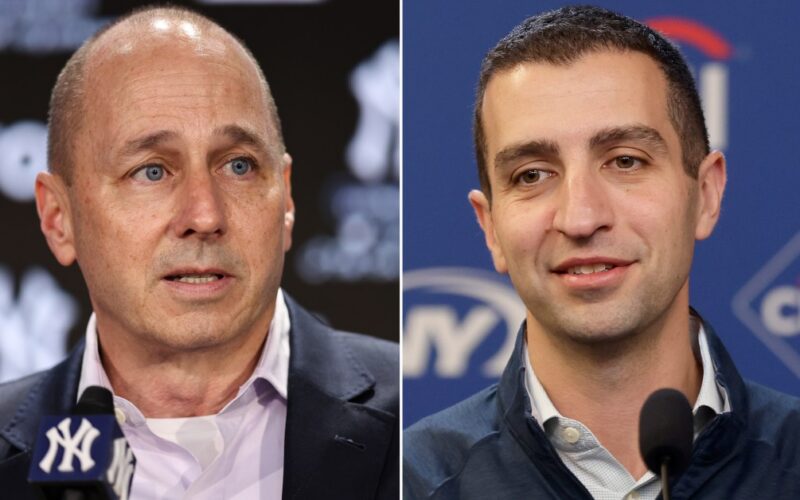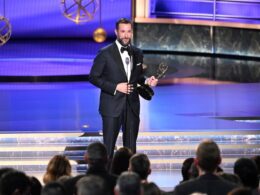When the dust settled after one of the busiest and dizziest trade deadlines of recent memory, both Brian Cashman and David Stearns emerged with significantly improved teams even if they were unable to secure one of their biggest needs — another frontline starting pitcher.
You could say Cashman had the bigger task in that the Yankees had been a fundamentally and defensively challenged 11-13 teams for the month of July, with a continuing one-dimensional home run-or-bust offense, and the general consensus has been that they just aren’t a very good team. Hard to correct all of that, but Cashman sought to position the Yankees for an October run by fortifying his very shaky bullpen (21st worst 4.24 ERA in baseball, 6.29 in July) with deals for another closer in David Bednar from the Pirates and two new set-up relievers in hard-throwing Camilo Doval from the Giants and finesse righty Jake Bird from the Rockies.
Bullpen arms were the top priority at the trade deadline, because come October it is the bullpens that most often are the deciding factors. Cashman got three really good ones who, combined with Devin Williams and Luke Weaver and soon-to-return Fernando Cruz and Mark Leiter Jr., suddenly give the Yankees about the deepest pen, quality-wise, of all the AL contenders.
The 30-year-old Bednar, a two-time All-Star, was the prize with a 2.37 ERA, 17 saves and 51 strikeouts in 38 innings, and was sought after by a half-dozen clubs. But Cashman did not stop there. Hoping to further bolster the Yankee pitching with another starter, he inquired about both Miami’s Sandy Alcantara and the Pirates’ Mitch Keller, neither of whom turned out to be available, unless Cashman was willing to talk Spencer Jones or George Lombard Jr. — which he wasn’t. But in a stealth last-minute deal before the deadline he was able to add some more athleticism as well as some infield defense insurance by acquiring Jose Caballero, who led the AL in stolen bases last year, from the Rays.
In none of these deals did Cashman surrender any top prospects that could contribute to the Yankees in the near future. More importantly he heeded his mentor Gene Michael’s credo of “never trading for a player who is unsigned” as the Yankees have control over all of the players they acquired beyond this year.
Like Cashman, Stearns prioritized pitching at the deadline, with a secondary need of a center fielder. He, too, found the starting pitching market extremely prohibitive. With one exception (the Diamondbacks with Merrill Kelly) teams were simply not willing to part with quality starting pitching, so Stearns quickly pursued relievers, especially after his Philly rival Dave Dombrowski pounced first by snatching up the Twins’ Jhoan Duran, one of three top flight closers (along with Bednar and the A’s Mason Miller) dealt at the deadline. Stearns’ counterpunch to that was to ship Jose Butto and prospects Drew Gilbert and Blake Tidwell to the Giants for Tyler Rogers, one of the elite set-up men in the game (1.80 ERA and just four walks over 50 innings).
It was a hefty price for a pitcher in his walk year, but Stearns made it clear he’s all-in for this year, and since June 1 the Mets’ bullpen ERA of 5.02 ranked 27th in the majors, prompting him to further strengthen it by adding Cardinals’ fireballing closer Ryan Helsley — also in his walk year — and lefty set-up man Gregory Soto from the Orioles a day earlier.
In the end, Stearns kept all his top prospects and strengthened the Mets’ pen considerably, and still had enough chips to out-flank Dombrowski for Orioles’ center fielder Cedric Mullins. Both clubs were seeking center fielders but apparently the Orioles were unimpressed with the Phillies’ prospects and Dombrowski was forced to settle on the much-traveled ex-Yankee and Met, Harrison Bader, who was nevertheless having one of his best offensive seasons for the Twins.
Here are the assessments of two rival execs on the Yankees’ and Mets’ trade deadline moves: “I think both teams more than accomplished their objectives of significantly upgrading their bullpens,” said one. “On the other hand both their rotations are short in my opinion and both are probably going to need bigger-than-expected contributions from their youngsters within — the Yankees from [Will] Warren and [Cam] Schlittler and the Mets from [Brandon] Sproat and [Nolan] McLean.” Said the other exec: “I like the fact that Cashman got all players with control whereas every player Stearns got can walk after this year. I’m also a little concerned about Helsley in New York. He didn’t handle adversity well in St. Louis.”
IT’S A MADD, MADD WORLD
What would the trade deadline be without A.J. Preller? The Padres GM, who never met a prospect he couldn’t trade, was at his manic best, leaving no need unfilled, in a flurry of trades that netted San Diego (1) the top closer in the game in Mason Miller from the A’s, (2) an offensive catcher in Freddy Fermin from the Royals, (3) two back-end starting pitchers in ex-Yankees JP Sears from the A’s and Nestor Cortes from the Brewers, and (4) a pair of outfield bats in Ramon Laureano and Ryan O’Hearn from the Orioles. To amass this haul, Preller sacrificed a whopping 14 of the Padres’ prospects, including Baseball America’s overall No, 3, shortstop Leo De Vries, and the Padres’ own Nos. 3, 4, 6 and 7. The spectacular acquisition of Miller, which required giving up De Vries, was especially puzzling in that, in Robert Suarez, the Padres already had the MLB saves leader. But as Preller explained: “It gives [Padres manager] Mike [Shildt] an opportunity to mix and match with the ‘pen and on certain nights go with one set of relievers and give guys an opportunity to get a little bit of rest.” Preller cited the acquisition of Fermin, who was batting .255 with a .648 OPS as the backup catcher to Salvador Perez in Kansas City, was especially important in that the Padres’ previous catchers, Martin Maldonado and Elias Diaz had a combined .596 OPS. In addition, the platoon of Laureano and O’Hearn should solve the Padres’ longtime offensive void in left field where a total of 10 players had combined to hit .229 with a .613 OPS this year, third worst among left fielders in the majors. “If you’re gonna win a world championship, you can’t have any weak links,” said Preller.








